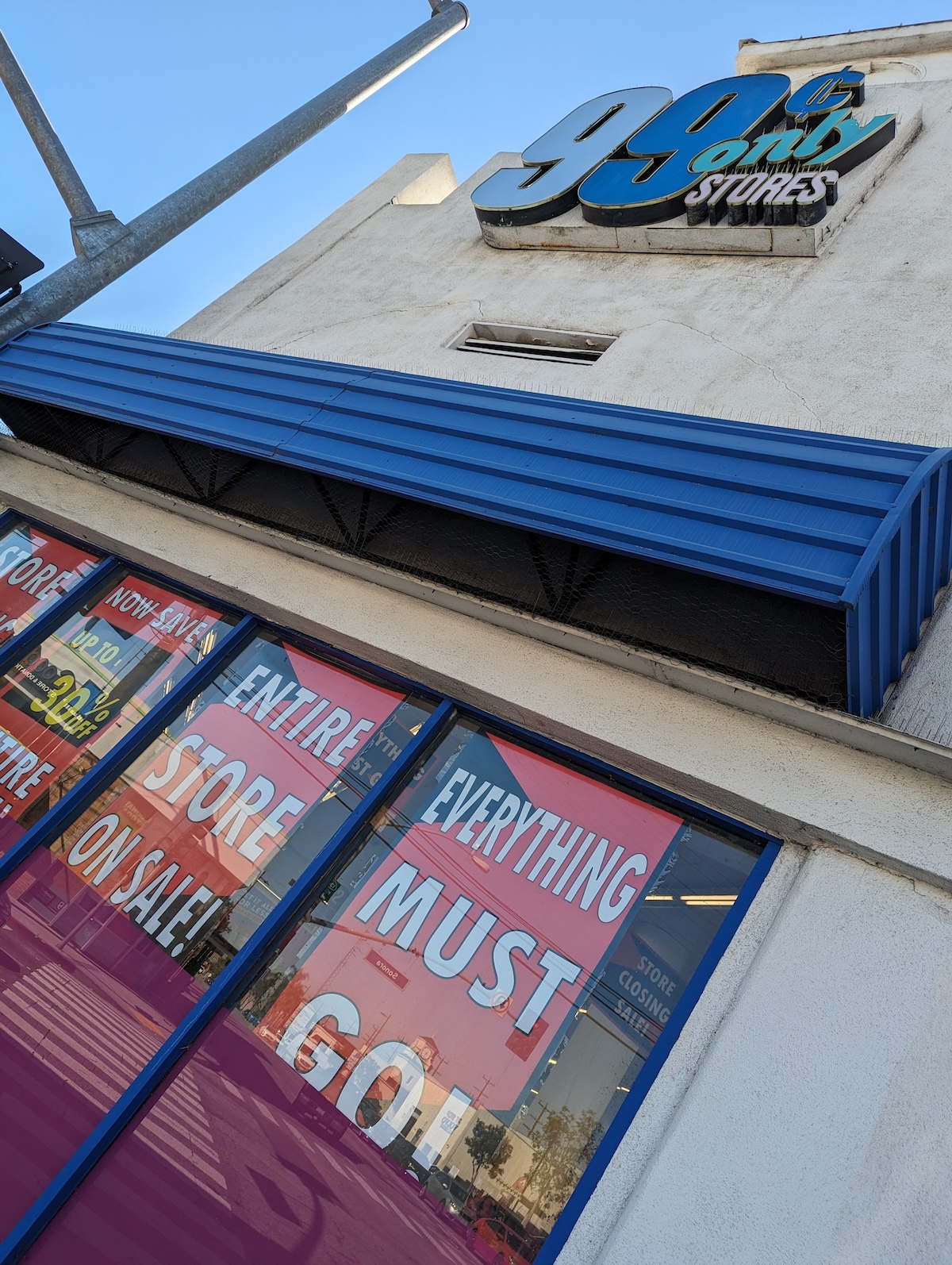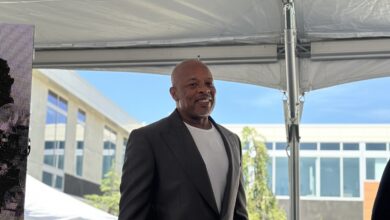Hope for 99 Cents Only Stores?

As 99 Cents Only Stores continues its liquidation and shutdown, observers see the silver lining of opportunity in the coming loss of a beloved Southern California brand.
Then again, one local investor – who boasts a discount retail background – is trying to save at least a portion of those stores in an effort to carry on the brand to better days.
The Commerce-based discount grocer and retailer, largely citing debt-related challenges and the costs of doing business, filed for chapter 11 bankruptcy on April 7 after failing to find prospective buyers and renegotiate with creditors. The filing came days after the company announced its shutdown and a liquidation sale that slashed prices across its 371 stores in California, Nevada, Arizona and Texas.
Chris Wilson, national agency retail lead for real estate services firm Jones Lang LaSalle Inc., said while he was sorry to see the “legendary retailer” go down, he felt it would ultimately shake up the market in a positive way.
“There’s been a supply imbalance throughout the country for the last three years, with interest rates starting to rise in the first quarter of 2022,” said Wilson, who is based at JLL’s downtown office. “We’ve basically seen redevelopment projects sidelined. As the result of that, and the extremely strong consumer economy, there’s a lot of retailers looking for space.
“You’re going to see a massive shakeup, with tons of retailers showing interest in these buildings,” he added.
Rise and fall of a brand
Founded in 1982 by Cleveland expat Dave Gold, the 99 Cents Only Stores – sometimes branded as the 99 Cent Store – quickly took off from its initial Ladera Heights location. The company went public in 1996 and in 2011 went private again after private equity firm Ares Management and the Canada Public Pension Plan Investment Board bought out the shares in a $1.6 billion transaction.
With inventory that depended largely on who was offloading product in a particular area, the stores became known for “treasure hunting” by customers shopping for one thing and finding other pleasant surprises on the shelves. You were as likely to find a brand-name product as its generic alternative – and very often for just 99 cents.
“Even though it was a multibillion-dollar company, 99 Cents Only operated under a premise straight from the Great Depression: a fair shake for everyone who entered,” Gustavo Arellano, a columnist with the Los Angeles Times, wrote last week. “Here, the retiree shopped alongside the hipster, and the only colors that mattered were the bright blue and pink on the marquee of each store. The chain had locations in blue-collar towns such as Santa Ana and Colton, but also suburbs such as Alhambra and Santa Monica.”
In the company’s bankruptcy filings, Chief Restructuring Officer Christopher Wells indicated that, like its retail competitors, 99 Cents Only Stores struggled to combat supply chain issues, fluctuating customer counts, inflation, the cost of labor and retail theft since the onset of the Covid-19 pandemic in 2020. The company was emerging from a major debt restructuring when the pandemic took hold, and it refinanced debt and secured $200 million in equity to keep the ship afloat.
Still, rising costs and retail theft forced the company to raise prices, Wells said, with the amount of merchandise priced at 99 cents or less dropping to below 50% by 2023.
“The company had no choice but to pass on to its customers some of the resulting costs, in the form of higher prices, which was met by significant customer resistance and reduced customer traffic,” he added in the filing.
Attempts in the last few months to find options to raise financing, seek a merger, selling the company, right-size its operational footprint and negotiate with creditors ultimately went nowhere.
“Usually when you have a company with that many stores, you would typically find some restructure option,” observed Richard Rizika, founder and president of El Segundo-based real estate brokerage and advisory firm Beta Agency. “That’s what we’ve been seeing with a lot of retailers in distress. It came as a surprise to a lot of people that they filed bankruptcy the way that they did.”
Good opportunity for newcomers
Whatever happens to the 99 Cents Only Brand, it’s likely that its empty storefronts will be filled sooner rather than later.
Rizika said, according to his company’s research on the retailer, there were 164 stores in the Los Angeles Metropolitan Statistical Area – an area that includes Orange County – comprising 3.8 million square feet. Within the county there also is a distribution center of several hundred thousand square feet in the vicinity of the San Pedro Bay port complex.
“A lot of these are urban infill locations. Most have good parking and access and visibility. I would expect to see interest from grocers, discounters as well as fitness and other uses that would be able to utilize the existing footprints,” Rizika said. “You have an opportunity to come into a market and be open overnight.”
It isn’t without precedent. Wilson, at JLL, highlighted that retail giant Target entered the L.A. market after Gemco closed its doors in 1986. He said the real estate world was “buzzing” at the potential opportunities here.
“I can’t tell you with any certainty, but I promise there are retailers in America right now looking at those footprints and wondering whether this is the time to enter Southern California,” Wilson said. “There are stores that have been sitting on the same real estate for 20 to 25 years and there’s all kinds of buildup sitting around them. The opportunity to enter those intersections, those lots, is historic for a lot of people.”
Could the brand be saved – partially?
If one entrepreneur has his way, he’ll enter those lots with the same 99 Cents Only Stores branding.
Mark Miller, president of Culver City-based Pic ‘N’ Save Bargains, has signaled his hopes of acquiring all of the Southern California locations of the 99 Cents Only Stores. Formerly president of Big Lots – which acquired the original Pick ‘N’ Save and converted those locations – Miller relaunched Pic ‘N’ Save in 2020, with the initial store in Anaheim. He has since opened a second location in Whittier.
The La Cañada Flintridge-based businessman said he came to know Gold, the 99 Cents Only Stores founder, as a friend and friendly competitor. When he restarted Pic ‘N’ Save, he said he tried to emulate the “never know what you’re going to get” experience of Gold’s empire.
Miller said he sees the root of 99 Cents Only Stores’ problems being that it started to lose that magic as it lost touch with its customer base.
“I think over the years, that’s just kind of drifted away,” he said. “When you go from entrepreneurial to private equity, that kind of goes away.”
As the liquidation continues, Miller said he has a bankruptcy attorney in “constant communication” with all parties. In addition to all – or some – of the 143 SoCal stores, he said he also has his eyes on two of the distribution centers in Commerce and would like to headquarter the reignited company at one of them.
“I think we’re in as good a position as anybody to take a piece of these 143 stores,” Miller added.
In any case, Rizika said the opportunity for small-format grocers or other discount retailers was ripe. The undoing of 99 Cents Only Stores, he noted, came largely as a result of bad debt, so if an investor or company has strong financial backing they may be able to avoid that issue.
“I’d like to think there is an opportunity to improve the quality of retail as new owners backfill these existing stores,” Rizika said. “As long as these owners have a basis in real estate and the liquidity to create these conversions, they should be able to do well.”




